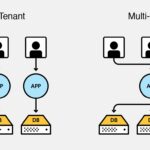In today’s economy, data acts as an invaluable resource for businesses, driving decision-making, innovation, and growth. By leveraging data, businesses gain insights into emerging opportunities, consumer demands, and competitive landscapes. And the more data a company can cultivate, the more opportunities they can harvest. However, as enterprises expand, they often inadvertently create isolated pockets of information or “data silos.” This compartmentalization can hinder productivity, stall decision-making processes, and hinder the flow of information. Fortunately, SAP S/4HANA’s ERP solution is a powerful tool that businesses can utilize to address these pitfalls.
Understanding Data Silos
Before delving into SAP’s ERP solution, it’s crucial to grasp the nature of the problem. Data silos occur when information is stored in separate departments or systems without an integrated approach. This not only impedes the flow of data but also affects collaboration, analytics, and overall business efficiency since these isolated subsets of data remain inaccessible to other parts of an organization. Such problems can emerge due to various reasons:
- Different departments using different systems and software.
- Historical decisions about IT infrastructure that lead to disparate databases.
- Geographical disparities in multinational companies.
- A lack of standardized protocols and data management strategies.
The Drawbacks of Data Silos

- Inefficiency: Information trapped in silos can lead to redundant efforts, as teams might unknowingly work on similar tasks without shared insights.
- Reduced Collaboration: When information is isolated, teams miss out on the chance to collaborate and bring interdisciplinary knowledge to a project.
- Missed Opportunities: Critical insights might remain undiscovered if data is not analyzed holistically.
Why SAP S/4HANA is the Answer
- Unified Data Model: One of the most compelling features of SAP S/4HANA is its single source of truth. By consolidating data structures and eliminating redundancies, the system ensures that all business units access consistent and updated data.
- Real-time Data Analytics Access: In the era of instant gratification, waiting for data updates is not an option. With its in-memory database, SAP S/4HANA allows real-time data access and analytics, breaking down silos and enabling immediate decision-making.
- Centralized Data Governance: SAP S/4HANA offers robust data governance tools that standardize data input and processing. This ensures that regardless of the department or function, data remains consistent and of high quality.
- Seamless Integration: Whether you’re integrating data from legacy systems, third-party solutions, or IoT devices, SAP S/4HANA provides the connectors and integration tools to bring all this data under one umbrella.
- Integration Capabilities: S/4HANA can be seamlessly integrated with a plethora of other tools and platforms, ensuring that data from various sources can be combined and analyzed collectively.
Breaking Down Compartmentalization
Data compartmentalization is a nuanced challenge where data is segmented based on business functions or departments. While at times necessary for security reasons, excessive compartmentalization can stifle cross-functional collaboration.
- Role-Based Access: With SAP S/4HANA, businesses can maintain data security by assigning role-based access. This ensures that while data is centralized, only authorized personnel can access sensitive information.
- Collaborative Tools: The platform offers various collaboration tools, ensuring that teams across departments can communicate effectively, sharing insights and data effortlessly.
- Data Sharing Workflows: SAP S/4HANA provides the capability to define and automate data sharing workflows. This allows organizations to establish structured processes for requesting and granting access to specific data, ensuring that collaboration is efficient and secure.
- Centralized Data Repository: While data compartmentalization is essential, SAP S/4HANA offers a centralized data repository where data from various departments and functions can be stored, making it easier to access and collaborate on shared data when necessary.
- Real-Time Analytics: The platform offers real-time analytics and reporting capabilities, enabling cross-functional teams to access up-to-date insights and data visualizations. This facilitates data-driven decision-making and collaboration, as teams can work with the same, current information.
- Data Virtualization: SAP S/4HANA includes data virtualization features that allow users to access and analyze data from various sources and systems without physically moving or duplicating the data. This promotes collaboration by providing a unified view of data across the organization.
- Mobile Accessibility: The platform’s mobile applications and accessibility options enable employees to collaborate and access data securely from anywhere, fostering remote teamwork and improving responsiveness to business needs.
- Integration Capabilities: SAP S/4HANA can be integrated with other SAP solutions and third-party applications. This facilitates data sharing and collaboration across different software systems, ensuring that data flows seamlessly between departments.
- Data Quality Management: Ensuring data accuracy and consistency is vital for collaboration. SAP S/4HANA offers data quality management tools that help maintain data integrity, reducing the risk of miscommunication or errors when collaborating on shared data.
- Security Features: Beyond role-based access, SAP S/4HANA includes robust security features like data encryption, identity and access management, and compliance controls. These features enhance data protection while facilitating secure collaboration.
- Collaborative Workspaces: SAP S/4HANA can provide collaborative workspaces where teams can work together on projects, share documents, and collaborate on data analysis. This creates a central hub for cross-functional teams to collaborate effectively.
- Customizable Reporting: Users can create customizable reports and dashboards in SAP S/4HANA, tailoring them to their specific collaboration needs. This flexibility enables teams to focus on the data most relevant to their projects.
Best Practices for Implementation
- Assess Current Data Architecture: Before migrating to SAP S/4HANA, evaluate your existing data structures. Understand where the silos exist and the reasons behind them.
- Engage Stakeholders: Ensure all departments are on board. Highlight the benefits of a unified system, from faster reporting to improved analytics.
- Prioritize Data Quality and Integration: As you migrate data, emphasize its cleanliness and accuracy. Use this transition as an opportunity to purge outdated or redundant data. Ensure that all platforms and tools used by your organization can communicate effectively with the ERP system.
- Continuous Training: All users need to understand the capabilities and features of SAP S/4HANA. Regular training sessions can keep them updated with the platform’s evolving functionalities.
Conclusion
In the digital era, the importance of data cannot be overstated. As organizations grow, the risk of creating data silos becomes more prominent, leading to inefficiencies, missed opportunities, and a lack of collaboration. SAP S/4HANA presents a transformative solution, offering businesses the ability to break down these silos while promoting seamless integration, collaboration, and real-time data access. By understanding the challenge of data silos and harnessing the potent capabilities of SAP S/4HANA, businesses can navigate the complexities of today’s data landscape. Implementing this ERP system with a focus on data quality, stakeholder engagement, and continuous training will position organizations for success in a data-driven future. Embracing the power of SAP S/4HANA not only modernizes business operations but also fosters an environment of informed decision-making and innovative growth.
Reach out to oXya today and take the next step in your digital transformation journey.
Contact








